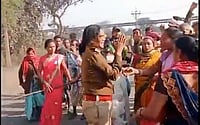The letter asked simply for a 1,000-word story on Iyer cuisine, done in an “affectionate, provocative style” but within minutes I was in knots. The first question was taxonomical: what was Iyer cuisine? Was it what Iyers cooked, or what Iyers ate? I’ve seen one Iyer brazenly eating a chicken burger at a McDonald’s—later washed down with curd-rice from a tiffin box. I once saw an Iyer couple at Oh! Calcutta, now internationally ranked among the top five restaurants in India, and they were furtively eating steamed hilsa.
The more troubling question was: who is an Iyer? Some irredeemably selfish fellow, living forever in the first person? Was I an I-yer? The food that made us from scrawny Tamil boys in knickers into men with strings attached, was that Iyer cuisine? And if I conceded it in print, what would my two children think of me? I have spent years telling them caste is a rotten thing and that our family has neither caste nor ethnicity, and then one day, the Iyer in me crawls out of the sawdust, ready for prayer and food. Whatever would they think?
My daughter can put away an entire meal of rice mashed together by hand with plain-cooked tuver dal, blessed with a touch of hot home-made ghee and a pugil of salt. She will have nothing else and go to sleep with a smile on her face. She has no idea that her father ate the same thing day after day as a schoolboy, together with other fare so simple that Dr Atkins might have written a very different book if he’d met an Iyer first. We were brought up on food we didn’t know as Iyer cuisine. It was what mother made, and its hallmarks were how little oil it deployed, how economically the vegetables were cooked, and how a few strategic ingredients woke up deeply satisfying tastes.
This, it was revealed when we were old enough to know such things, was essentially the vegetarian cuisine of Palghat, associated with Palghat Iyers. We accepted the information without question, although by then I was already entertaining the notion that I was possibly not who I said I was. I viewed Palghat itself with suspicion—ghat was a very un-Tamil word. In fact, my aunts, standing in line, would pronounce it as Palakkadu. ‘Ghat’ is roughly a hill phenomenon in Hindi, as in Western Ghats, while a ‘kadu’ meant a forest in Tamil.
More to the point, I had been to neither the ghat nor the kadu. The ‘C’ in my name stood for Chittoor, which could have been the Kerala Chittoor or the Andhra Pradesh one, but there was no way of telling, since I had been born in Kottayam. Besides, in one Chittoor, Malayalam was spoken and in the other Telugu. I spoke only Tamil. I began to wonder whether I had been born at all.
Matters were resolved amicably by the Indian Book House in 1995, when they published a lovely little book called Southern Delights, by Parwathy Akhileswaran, with the kicker line on the cover reading ‘Recipes to Remember from Palakkad’. Within its 173 pages, it contained my childhood. It had milagootal (tuver dal, a coconut-based paste, and vegetables like spinach, squash, yam, snake gourd); olan (pumpkin, black-eyed peas, coconut milk); kaalan (elephant yam, spicy coconut paste); mor chaar (the simplest curry, made with sour curds and some magical garnishes); and on and on.
If that was the cuisine of Palakkad, and it was the food that grew me up, then Palakkad had to be the heartland of my cuisine. I quote: “Palakkad (Palghat) is a district in Kerala bordering Tamil Nadu. Many Tamilians have settled there, their lifestyles reflecting a blend of Tamilian and Keralite culture.... They combine the spices of Tamil Nadu with the coconuts of Kerala to give a unique and delicious flavour to their food.”

Note: Iyers are nowhere mentioned. We are now in no-man’s land. A Tamilian born in Kerala but who might actually have Andhra origins, who denies being an Iyer and whose normal diet in Bangkok is pad thai or noodles is writing affectionately and provocatively about food that may have nothing to do with Iyers, has its origins in Kerala and might not even be Tamil.
Well, as long as it tastes like heaven....
And it does. In a world drowning itself in multi-cuisine and going to hell in the mad diets of its Dr Atkinses, the food I grew up on—let’s call it Iyer cuisine only for convenience—stands out for its elegance, simplicity, taste. I was nearly 40 before I figured out that the power of Iyer cuisine lies in the fact that it creates not recipes but templates. Let me illustrate.
Long ago, in some distant kitchen, a devout Iyer had an epiphany when she realised that if you wanted to wake up the flavour of a vegetable instead of change it, you could not possibly use spices. Spices add new tastes. The counter-intuitive insight was that a teaspoonful of lentils, fried golden brown, could inexplicably wake up the natural taste of the food, like ajinomoto, but without the Chinese restaurant syndrome.
From this there emerged a simple garnish. You can use virtually any vegetable—chopped spinach, beans, okra, cauliflower, gourds. Certain others, such as yam, potatoes and pumpkins, need to be partly boiled before being stir-fried. Use very hot peanut oil, and throw in a few mustard seeds, some curry leaves, and a pinch of white urad dal. Fry till the urad is golden and the mustard is spluttering, add some dry red chillies and a pinch of asafoetida. Throw in the vegetables and stir-fry quickly, making sure they don’t lose colour. If you like, add a few spoons of grated coconut at the end. Serve with rice, and sambar or rasam.
(The writer, a journalist, author, film maker and social activist, lives by the mantra, ‘Eat well, think better, be kind’.)


























